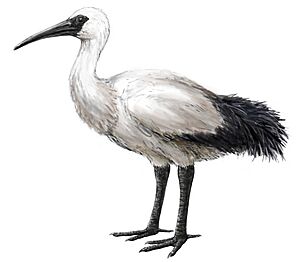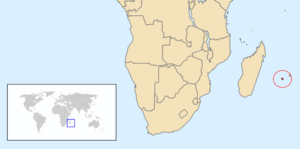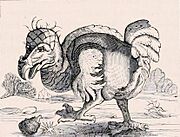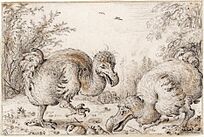Réunion ibis facts for kids
Quick facts for kids Réunion ibis |
|
|---|---|
 |
|
| Hypothetical restoration based on contemporary descriptions, subfossil remains, and extant relatives | |
| Conservation status | |
| Scientific classification | |
| Genus: |
Threskiornis
|
| Species: |
solitarius
|
 |
|
| Location of Réunion (encircled) | |
| Synonyms | |
|
List
Apterornis solitarius Sélys, 1848
Raphus solitarius Sélys, 1848 Didus apterornis (Schlegel, 1854) Pezophaps borbonica Bonaparte, 1854 Ornithaptera borbonica (Bonaparte, 1854) Apterornis solitaria (Milne-Edwards, 1869) Didus borbonica (Schlegel, 1873) Didus borbonicus (Schlegel, 1875) Ornithaptera solitarius (Hachisuka, 1953) Victoriornis imperialis Hachisuka, 1937 Borbonibis latipes Mourer & Moutou, 1987 |
|
The Réunion ibis or Réunion sacred ibis (Threskiornis solitarius) is an extinct species of ibis that was endemic to the volcanic island of Réunion in the Indian Ocean. The first subfossil remains were found in 1974, and the ibis was first scientifically described in 1987. Its closest relatives are the Malagasy sacred ibis, the African sacred ibis, and the straw-necked ibis. Travellers' accounts from the 17th and 18th centuries described a white bird on Réunion that flew with difficulty and preferred solitude, which was subsequently referred to as the "Réunion solitaire".
In the mid 19th century, the old travellers' accounts were incorrectly assumed to refer to white relatives of the dodo, due to one account specifically mentioning dodos on the island, and because 17th-century paintings of white dodos had recently surfaced. However, no fossils referable to dodo-like birds were ever found on Réunion, and it was later questioned whether the paintings had anything to do with the island. Other identities were suggested as well, based only on speculations. In the late 20th century, the discovery of ibis subfossils led to the idea that the old accounts actually referred to an ibis species instead. The idea that the "solitaire" and the subfossil ibis are identical was met with limited dissent, but is now widely accepted.
Combined, the old descriptions and subfossils show that the Réunion ibis was mainly white, with this colour merging into yellow and grey. The wing tips and plumes of ostrich-like feathers on its rear were black. The neck and legs were long, and the beak was relatively straight and short for an ibis. It was more robust in build than its extant relatives, but was otherwise quite similar to them. It would have been no longer than 65 cm (25 in) in length. Subfossil wingbones indicate it had reduced flight capabilities, a feature perhaps linked to seasonal fattening. The diet of the Réunion ibis was worms and other items foraged from the soil. In the 17th century, it lived in mountainous areas, but it may have been confined to these remote heights by heavy hunting by humans and predation by introduced animals in the more accessible areas of the island. Visitors to Réunion praised its flavour, and therefore sought after its flesh. These factors are believed to have driven the Réunion ibis to extinction by the early 18th century.
Taxonomy
The taxonomic history of the Réunion ibis is convoluted and complex, due to the ambiguous and meagre evidence that was available to scientists until the late 20th century. The supposed "white dodo" of Réunion is now believed to have been an erroneous conjecture based on the few contemporary reports which described the Réunion ibis, combined with paintings of white dodos from Mauritius by the Dutch painters Pieter Withoos and Pieter Holsteyn II (and derivatives) from the 17th century that surfaced in the 19th century.
The English Chief Officer John Tatton was the first to mention a specifically white bird on Réunion, in 1625. The French occupied the island from 1646 and onwards, and referred to this bird as the "solitaire". M. Carré of the French East India Company described the "solitaire" in 1699, explaining the reason for its name:
I saw a kind of bird in this place which I have not found elsewhere; it is that which the inhabitants call the Oiseaux Solitaire for to be sure, it loves solitude and only frequents the most secluded places; one never sees two or more together; it is always alone. It is not unlike a turkey, if it did not have longer legs. The beauty of its plumage is a delight to see. It is of changeable colour which verges upon yellow. The flesh is exquisite; it forms one of the best dishes in this country, and might form a dainty at our tables. We wished to keep two of these birds to send to France and present them to His Majesty, but as soon as they were on board ship, they died of melancholy, having refused to eat or drink.
The marooned French Huguenot François Leguat used the name "solitaire" for the Rodrigues solitaire, a Raphine bird (related to the dodo) he encountered on the nearby island of Rodrigues in the 1690s, but it is thought he borrowed the name from a 1689 tract by Marquis Henri Duquesne which mentioned the Réunion species. Duquesne himself had probably based his own description on an earlier one. No specimens of the "solitaire" were ever preserved.
The two individuals Carré attempted to send to the royal menagerie in France did not survive in captivity. Billiard claimed that the French administrator Bertrand-François Mahé de La Bourdonnais sent a "solitaire" to France from Réunion around 1740. Since the Réunion ibis is believed to have gone extinct by this date, the bird may actually have been a Rodrigues solitaire.
The only contemporary writer who referred specifically to "dodos" inhabiting Réunion was the Dutch sailor Willem Ysbrandtszoon Bontekoe, though he did not mention their colouration:
There were also Dod-eersen [old Dutch for dodos], which have small wings, and so far from being able to fly, they were so fat that they could scarcely walk, and when they tried to run, they dragged their under side along the ground.
When his journal was published in 1646, it was accompanied by an engraving which is now known to have been copied after one of the dodos in the Flemish painter Roelant Savery's "Crocker Art Gallery sketch". Since Bontekoe was shipwrecked and lost all his belongings after visiting Réunion in 1619, he may not have written his account until he returned to Holland, seven years later, which would put its reliability in question. He may have concluded in hindsight that it was a dodo, finding what he saw similar to accounts of that bird.




